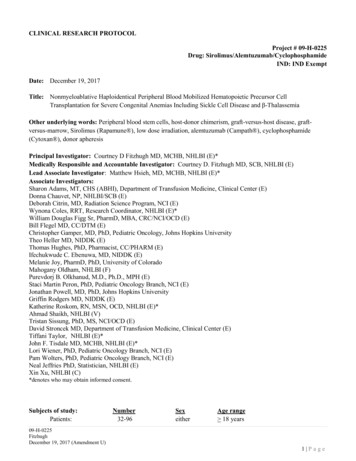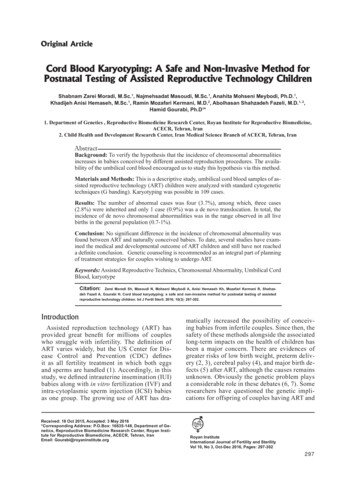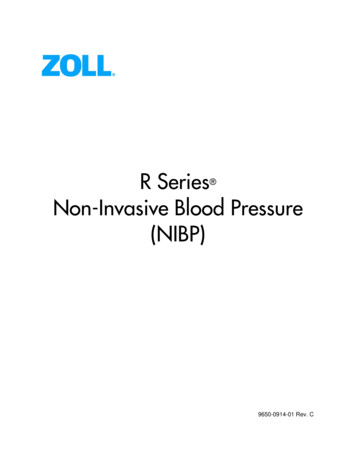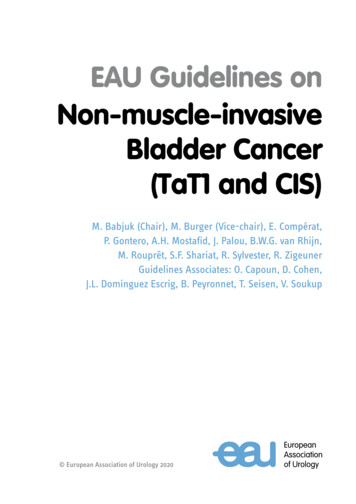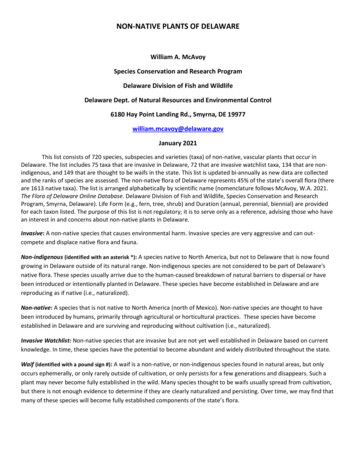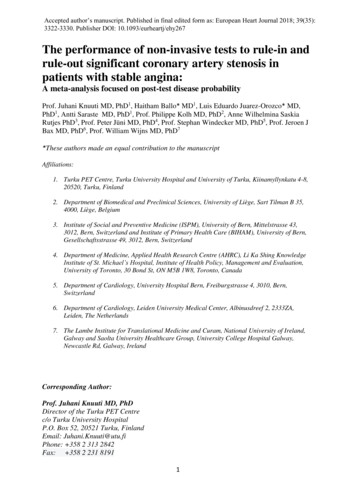
Transcription
Accepted author’s manuscript. Published in final edited form as: European Heart Journal 2018; 39(35):3322-3330. Publisher DOI: 10.1093/eurheartj/ehy267The performance of non-invasive tests to rule-in andrule-out significant coronary artery stenosis inpatients with stable angina:A meta-analysis focused on post-test disease probabilityProf. Juhani Knuuti MD, PhD1, Haitham Ballo* MD1, Luis Eduardo Juarez-Orozco* MD,PhD1, Antti Saraste MD, PhD1, Prof. Philippe Kolh MD, PhD2, Anne Wilhelmina SaskiaRutjes PhD3, Prof. Peter Jüni MD, PhD4, Prof. Stephan Windecker MD, PhD5, Prof. Jeroen JBax MD, PhD6, Prof. William Wijns MD, PhD7*These authors made an equal contribution to the manuscriptAffiliations:1. Turku PET Centre, Turku University Hospital and University of Turku, Kiinamyllynkatu 4-8,20520, Turku, Finland2. Department of Biomedical and Preclinical Sciences, University of Liège, Sart Tilman B 35,4000, Liège, Belgium3. Institute of Social and Preventive Medicine (ISPM), University of Bern, Mittelstrasse 43,3012, Bern, Switzerland and Institute of Primary Health Care (BIHAM), University of Bern,Gesellschaftsstrasse 49, 3012, Bern, Switzerland4. Department of Medicine, Applied Health Research Centre (AHRC), Li Ka Shing KnowledgeInstitute of St. Michael’s Hospital, Institute of Health Policy, Management and Evaluation,University of Toronto, 30 Bond St, ON M5B 1W8, Toronto, Canada5. Department of Cardiology, University Hospital Bern, Freiburgstrasse 4, 3010, Bern,Switzerland6. Department of Cardiology, Leiden University Medical Center, Albinusdreef 2, 2333ZA,Leiden, The Netherlands7. The Lambe Institute for Translational Medicine and Curam, National University of Ireland,Galway and Saolta University Healthcare Group, University College Hospital Galway,Newcastle Rd, Galway, IrelandCorresponding Author:Prof. Juhani Knuuti MD, PhDDirector of the Turku PET Centrec/o Turku University HospitalP.O. Box 52, 20521 Turku, FinlandEmail: Juhani.Knuuti@utu.fiPhone: 358 2 313 2842Fax: 358 2 231 81911
AbbreviationsCADCoronary artery diseaseCCTA Coronary computed tomography angiographyCMR Cardiovascular magnetic resonanceICAInvasive coronary angiographyIVUS Intravascular ultrasoundOCTOptical coherence tomographyPETPositron emission tomographyPTPPre-test probabilityQCAQuantitative coronary angiographySPECT Single photon emission computed tomography2
ABSTRACTAimsTo determine the ranges of pre-test probability (PTP) of CAD in which stress ECG, stressechocardiography, coronary computed tomography angiography (CCTA), single-photon emissioncomputed tomography (SPECT), positron emission tomography (PET) and cardiac magneticresonance (CMR) can reclassify patients into a post-test probability that defines ( 85%) or excludes( 15%) anatomically (defined by visual evaluation of invasive coronary angiography [ICA]) andfunctionally (defined by a fractional flow reserve [FFR] 0.80) significant CAD.Methods and ResultsA broad search in electronic databases until August 2017 was performed. Studies on theaforementioned techniques in 100 patients with stable CAD that utilized either ICA or ICA with FFRmeasurement as reference, were included. Study-level data was pooled using a hierarchical bivariaterandom-effects model and likelihood ratios were obtained for each technique. The PTP ranges for eachtechnique to rule-in or rule-out significant CAD were defined. 28,664 patients from 132 studies thatused ICA as reference and 4,131 from 23 studies using FFR, were analyzed.Stress ECG can rule-in and rule-out anatomically significant CAD only when PTP is 80% [76, 83]and 19% [15, 25], respectively. CCTA is able to rule-in anatomic CAD at a PTP 58% [45, 70] andrule-out at a PTP 80% [65, 94]. The corresponding PTP values for functionally significant CAD were 75% [67, 83] and 57% [40, 72] for CCTA, and 71% [59, 81] and 27 [24, 31] for ICA,demonstrating poorer performance of anatomic imaging against FFR. In contrast, functional imagingtechniques (PET, stress CMR and SPECT) are able to rule-in functionally significant CAD when PTPis 46-59% and rule-out when PTP is 34-57%.ConclusionThe various diagnostic modalities have different optimal performance ranges for the detection ofanatomically and functionally significant CAD. Stress ECG appears to have very limited diagnosticpower. The selection of a diagnostic technique for any given patient to rule-in or rule-out CAD shouldbe based on the optimal PTP range for each test and on the basis of the assumed reference standard.3
Keywords: Stable coronary artery disease, non-invasive imaging, pre-test probability, post-testprobability, likelihood ratio4
INTRODUCTIONAccurate detection of coronary artery disease (CAD) remains paramount in thepractice of cardiology. Traditionally, the characterization of “significant” CAD has reliedupon visual evaluation of coronary artery stenosis during invasive coronary angiography(ICA). However, the severity of angiographic stenosis does not unequivocally reflect itsfunctional significance.(1) Recently, the invasive assessment of fractional flow reserve (FFR)has been adopted to identify functionally significant coronary artery stenoses.(2) Yet, FFRevaluation is not without limitations as diffuse CAD and hemodynamic conditions haveshown an influence on its estimation, it is inherently invasive and costly, and it still does notrepresent the most common practice in invasive evaluation of CAD.(3)Stable CAD is understood as the condition characterized by episodes of inducible andreversible ischemia commonly associated with transient chest discomfort. The currentEuropean and American guidelines on the management of stable CAD(2,4) recommend thatpatients with an intermediate pre-test probability (PTP) (ranging from 15 to 85%) ofsignificant CAD should undergo non-invasive evaluation(5,6). In subjects whose probabilityof a significant coronary artery narrowing is low ( 15%), routine testing is not recommended.On the other hand, patients with a high probability ( 85%) of the disease calls for directtherapeutic interventions.In the group of patients with intermediate PTP of significant CAD, the currentrecommendations for the selection of the optimal non-invasive technique are broad and do notassign preference of one modality over another. Certain techniques are broadly availablebecause of their relative low technical and personnel demands (such as stress ECG) or goodavailability (stress echocardiography, coronary computed tomography angiography [CCTA],and single-photon emission computed tomography [SPECT]), while others, like positronemission tomography (PET) and stress cardiac magnetic resonance (CMR), although5
powerful, are much less available and their applicability is still limited by infrastructural andcapacity requirements (7).It is expected that each technique has a particular range of PTP of significant CADwhere the usefulness of its application is maximized. The performance of non-invasivetechniques is generally reported in terms of sensitivity and specificity. Nevertheless, thesenumbers cannot be readily utilized in the clinical decision-making process. They can howeverbe used to derive positive and negative likelihood ratios (LR and LR-), which constitutereadily useful parameters of a test’s accuracy that facilitate the selection of a diagnostic testfor individual patients.(8) Given a PTP of significant CAD and the performance of a particulartest by means of its LR’s, one can assess the post-test probability of significant CAD afterperforming such test. Using this approach, one can estimate the range of PTP when a positiveor negative test result can confidently rule-in (if the post-test probability goes beyond 85%) orrule-out (if the post-test probability drops below 15%) the disease.As currently both anatomical (ICA) and functional (FFR) reference standards areutilized, it is rational to consider evidence using both standards.(9) The anatomical standardhas been used in most of the studies available today and there is a massive amount ofevidence, although functional information has gained increasing interest. It can be expectedthat some tests demonstrate better agreement with ICA while others with FFR. Therefore,integration of all available data may provide important clinical information for consciousselection of the tests.The aim of the present systematic review and meta-analysis was to evaluate thediagnostic performance of stress ECG, stress echocardiography, CCTA, SPECT, PET, stressCMR, and ICA in the detection of anatomically and functionally significant CAD in order todetermine the optimal range of PTP in the diagnostic application of each technique for rulingin or ruling-out significant CAD.6
7
METHODSThe present systematic review was conducted in accordance to the Preferred Reportingitems for Systematic Reviews and Meta-analysis (PRISMA)(10) recommendations and theMOOSE checklist (see results and e-Table 1 in the supplement).(11)Data SourcesWe performed a systematic search for original studies published until August 2017that reported on the diagnostic performance of stress ECG, stress echocardiography, CCTA,SPECT, PET, stress CMR, and ICA for the detection of significant CAD.The search was performed in electronic databases (Medline, Embase, PubMed,Scopus, The Cochrane Library, Web of Science, ProQuest) using a broad strategy with acombination of MeSH terms and free text words sensitive to: identify studies concerning 1)the aforementioned diagnostic techniques, 2) diagnostic performance, 3) patients withintermediate pre-test probability of the condition, and 4) significant CAD. The search resultswere limited to the English language and to studies performed in humans. The full searchstring is reported in e-Table 2. Reference lists from relevant studies were scanned and crosschecked to identify potentially overlooked publications.Study Selection and Quality AssessmentStudies were included according to the following eligibility criteria: 1) the study aimedto investigate stable CAD (not acute coronary syndromes), 2) either catheter-based X-rayangiography (ICA) or ICA with FFR evaluation were used as the reference standard for thediagnosis of stable CAD, 3) the reported data was explicit or sufficient to extract numbers fortrue and false positive and negative results, and 4) the study included a sample of at least 100patients (for robustness). Selected studies were further divided according to the referencestandard considered (ICA or FFR evaluation).8
For each included study, the Quality Assessment of Diagnostic Accuracy Studies(QUADAS-2) criteria were determined by two authors (LJ and HB). The QUADAS-2 toolassesses the study quality in different domains including patient selection, index test,reference standard, and flow of patients through the study considering the timing of the indextest and reference standard. For each article, quality and applicability were assessed in theaforementioned domains as follows: “yes” if concern existed based on enough description inthe report, “no” if there was no concern based on enough description in the report or “unclear”if there was inadequate or insufficient information reported in the article to make a judgment.Data ExtractionData were recorded according to the technique and reference standard utilized. Thenumber of subjects, male to female patient proportion, age, type of stressor, tracer utilized (ifany), stable CAD definition, and prevalence were extracted. The number of true positives(TP), false positives (FP), true negatives (TN), and false negatives (FN), as well as deriveddiagnostic performance variables were recorded.Study review, quality evaluation, and data extraction were performed in parallel bytwo authors (AS and HB). Any specific discrepancies were resolved by consensus. Ifnecessary, a third reviewer (JK) was considered to reach convergence.Reference StandardCatheter-based ICA alone and ICA with FFR measurement were considered as thereference standards for the determination of anatomically significant and functionallysignificant CAD, respectively. Anatomic coronary narrowing 50% was considered asdeterminant of significant CAD and an FFR 0.80 was considered as functionally significantCAD.Data synthesis and statistical analysis9
Hierarchical bivariate random-effects models were constructed to combine individualstudy-level data on the sensitivities and specificities across studies. This model takes thecorrelation between sensitivity and specificity into account, and is described in detailelsewhere.(12) The bivariate model used parametrization to render summary points forsensitivity and specificity with 95% confidence intervals [CI] for each of the imagingtechniques. We used an unstructured covariance matrix allowing all variances and covariancesto be distinct. We then derived summary estimates of the LR and LR- with their confidenceintervals from the model estimates. For echocardiography and SPECT, more than one type ofstressor was used. We compared if a model distinguishing by type of stressor had a bettermodel fit than a model grouping all stressor techniques together. The analysis was performedseparately for anatomically and functionally significant CAD (according to the referencestandard used). We used the p-value from the likelihood ratio test to determine if the modelwith a covariate for the type of stressor fitted the data better than a model without suchcovariate. If the p-value was 0.05 or less, we depicted summary estimates for a specific typeof stressor.Utility of non-invasive approaches according to pre-test probability of stable CADOnce the positive and negative LRs of each non-invasive diagnostic technique wereobtained for both accepted reference standards, the ranges and in which every singletechnique allows to confidently rule-in CAD, rule-out CAD, or both were input into a colorcoded graph. Additionally, we created a supplemental color-coded suggestion over thestructure of the current ESC guidelines stable CAD PTP table to depict the suggested utility ofeach diagnostic technique at each level of risk based on age, sex, and type of symptoms.10
RESULTSStudy CharacteristicsThe study selection flow chart is shown in Figure 1. Specific characteristics and thefull reference for each selected study can be consulted in e-Table 3 in the Supplement. Aftereligibility assessment and technique subgroup characterization, 13 studies on stress ECG, 12studies on exercise stress echocardiography, 30 on dobutamine stress echocardiography, 9studies on CCTA, 28 studies on exercise & adenosine or dipyridamole stress SPECT, 13 onexercise stress SPECT, 3 studies on PET, and 11 on stress CMR were considered for thepooled analysis on anatomically significant CAD. On the other hand, 2 studies in ICA, 7studies on CCTA, 5 on exercise stress SPECT, 4 on PET, and 5 on stress CMR wereconsidered for the pooled analysis on functionally significant CAD.Study Heterogeneity and QualityRisk of bias in the included studies, as assessed with the QUADAS-2 score, showedimportant variation across diagnostic modalities. Overall, PET, CCTA, and stress CMRshowed a low risk of bias and therefore, did not raise substantial concerns of applicability.However, these modalities conveyed the smallest number of studies included. Conversely, theproportions of unclear ratings for ECG and echocardiography studies related to the year whenthese were performed. For the oldest studies, insufficient data for this assessment iscommonly reported. SPECT studies generally rated less well showing a balanced proportionof unclear and high risk of bias in all domains. E-Figure 1 in the Supplement shows thisassessment across techniques in an ascending order of risk. Overall quality per type ofreference standard is shown in Figure 2.Performance EstimatesThe pooled analysis considering anatomically significant CAD included a total of2,442 patients for stress ECG, 4,302 for stress echo (with exercise or vasodilator), 2,756 for11
CCTA, 4,346 for exercise stress SPECT, 6,551 for exercise & adenosine or dipyridamolestress SPECT, 418 for PET, and 3,393 for stress CMR. Further, the pooled analysisconsidering functionally significant CAD included 954 for ICA, 1,140 patients for CCTA,740 for exercise stress SPECT, 709 for PET, and 588 for stress CMR. Some studies evaluatedseveral techniques or technique subgroups simultaneously. Such studies were included asindependent entries in more than one pooled analysis per technique.Table 1 summarizes the performance estimates for every diagnostic techniqueaccording to each reference standard. Some techniques had various subcategories typicallyaccording to the type of stressor utilized. Some of these subcategories are less commonly usedor did not yield adequate information for a summary estimate (e.g. stress echo withdobutamine stress n 30, dobutamine stress SPECT n 2, and dobutamine stress CMR n 2)and were not included in these estimates.Considering anatomically significant CAD, there were 11 vasodilatory stressechocardiography studies and analysis considering 50% as significant stenosis yielded asensitivity of 0.75 [0.70, 0.80] and specificity of 0.91 [0.86, 0.94]. These summary estimateswere not statistically different from the summary estimates obtained for exercise stress echo(likelihood ratio test p-value 0.386) and were consequently pooled together. The summaryestimates obtained from 27 dobutamine stress echocardiography studies were 0.81 [0.77,0.85] for sensitivity and 0.84 [0.81, 0.87] for specificity and given that these estimates weresignificantly different from exercise stress echocardiography (likelihood ratio test pvalue 0.012), they were not pooled together but their references can be consulted in thesupplementary material.When anatomically significant CAD was used as reference standard, the LR– ofdifferent tests varied from 0.04 to 0.68. The best performance in ruling out CAD was achievedusing CCTA and poorest with stress ECG. The LR varied from 1.53 to 5.87. The best12
performance for ruling in CAD was achieved using PET and the poorest with stress ECG. TheLR and LR- for dobutamine stress echocardiography subgroup were 8.03 [4.98, 12.95] and0.27 [0.22, 0.34], respectively (not shown in the tables).When functionally significant CAD was considered as reference standard, LR– variedfrom 0.13 to 0.44. CCTA, PET, and stress CMR had the best and similar performance inruling out significant CAD (–LR 0.13 [0.07, 0.24]), while interestingly, ICA had the poorest.The LR of the available techniques varied from 1.97 to 7.10. The poorest performances inruling-in an abnormal FFR were documented for CCTA (LR 1.97 [1.28, 3.03]) and ICA(LR 2.49 [1.47, 4.21]), while functional imaging tests conversely demonstrated the bestperformance (LR range: 3.87-7.1). We could not identify enough robust studies to poolestimates for stress ECG and stress echocardiography.Effectiveness of non-invasive diagnostic techniques in ruling in/out significant CADThe Fagan nomogram is a useful tool to graphically apply LRs to a PTP to calculatethe post-test probability. A parallel example of its use is depicted in Figure 3, which showshow one can calculate the post-test probabilities after a positive or negative test result startingfrom any PTP in an individual patient.The same nomogram can be also utilized backwards so that we can assess the PTPvalues that will lead to a defined range of post-test probability for each diagnostic method.Therefore, using the data from the meta-analysis, we defined the ranges of PTP of CAD wherethe diagnostic techniques can confidently rule-in (by driving the post-test probability above85%) and/or rule-out (by driving the post-test probability below 15%) significant CAD. Thiswas done separately for both anatomically and functionally significant CAD. Such ranges areschematically shown along with their corresponding upper and lower limits in Figure 4 andnumerically reported in e-Table 4 in the Supplement.13
Finally, based on the obtained data described above, we transformed the PTP tablefrom the 2013 ESC Guidelines on the management of stable coronary artery disease (4) into asupplemental guide that exemplifies how clinicians could implement the resulting estimates ofperformance in this report in order to select a diagnostic test that confidently rules-in or rulesout CAD (both anatomically and functionally significant CAD) at each patient PTP category(e-Figure 2 panels A and B, respectively).DISCUSSIONThe present study analyzed the evidence on the performance of different diagnostictechniques for the detection of either anatomically or functionally significant CAD. Beyondreporting traditional metrics, we also portrayed their performance as LRs and defined theoptimal ranges of PTP for each test where they can reclassify patients from intermediate toeither low or high post-test probability of CAD (i.e. rule-out or rule-in, respectively).From this analysis several main messages can be driven. Stress ECG appears to havevery limited diagnostic power to rule-in or rule-out significant CAD. In fact, there was nosingle PTP value in which stress ECG can both define the diagnosis and exclude it. Moreover,even to confidently rule-out CAD, a very low PTP ( 19% [15, 25]) is needed, while forruling-in, a PTP 80% [76, 83] is required.As expected, the performance of imaging methods was clearly better than that of stressECG. However, there appears to be also differences between them. A negative result inCCTA, which conveys a strong LR-, can exclude anatomically defined CAD in nearly allpatients independently of their pre-test probability. The performance was clearly poorer whenFFR was considered the reference standard as CCTA could only exclude functionallysignificant CAD at a PTP 57% [40, 72]. Correspondingly, the rule-in power, that was14
moderate to good when considering ICA as reference, also clearly deteriorated when FFR wasused as reference standard.The functional imaging techniques (PET, CMR, SPECT), which had only moderatepower in identifying anatomically significant CAD, performed much better when FFR wasused as reference standard. This is in agreement with previous notions and a recentlypublished meta-analysis (9,13). PET and stress CMR demonstrated the best diagnosticperformance and offered reasonable range of pre-test probabilities where they couldsimultaneously rule-out or rule-in functionally significant CAD as shown in Figure 4.However, the comparison between functional imaging techniques must be done cautiously asnot enough data was available for stress echocardiography and SPECT studies were older.Furthermore, in more recent studies, referral bias to reference technique is a commonphenomenon with established techniques, which typically leads to underestimation of the testspecificity. Also, the recent technical advances in were not accounted for as the data washeavily weighted by older studies. Therefore, the previously established tests mayunderperform in the present analysis.We also assessed the performance of ICA itself in detecting functionally significantCAD even though it does not classify as a non-invasive test. ICA demonstrated the poorestruling-out performance of all analyzed techniques when the reference standard was FFR as aPTP 27% [24, 31] was needed to rule-out functional CAD. Consistently, the PTP range torule-in functionally significant CAD was rather modest ( 71% [59, 81]) and only slightlysuperior to CCTA ( 75% [67, 83]). This behavior fits well with the current recommendationthat ICA should be used primarily in patients with high PTP.Although a pooled evaluation of non-invasive imaging techniques for diagnosingfunctionally significant CAD has been performed recently, (14) the present study expands theevidence by also considering stress ECG performance, evaluating the competence of ICA15
alone in determining functionally significant CAD, conveying the practical ranges ofapplication for the involved diagnostic techniques and parsing the determination of CAD bothagainst anatomical and functional standards. This is timely and relevant considering thatanatomical definition of CAD is still widely used in the daily clinical scenario in manyhealthcare centers around the world, while at the same time acknowledging that FFR indeedrepresents the currently most adequate reference standard.Clinical implicationsOur clinical conclusions partly differ from those in the current clinical guidelines. Forexample, in ESC guidelines (4) stress ECG is recommended in patients with lowerintermediate PTP (15-65%) of CAD. Our analysis argues against this statement as thepractical utility of stress ECG in detecting CAD appears very limited (Figure 4A and e-Figure2A). However, exercise testing also provides complementary information beyond ECGchanges, such as exercise capacity, arrhythmias, hemodynamic response, and symptomsduring exercise, which are considered clinically useful. These, however, could not be takeninto account in the present analysis.CCTA has rapidly gained popularity mainly based on its high negative predictivevalue. This was confirmed in the present analysis by the low LR-, which suggests that anegative result can reliably rule-out anatomic CAD virtually at any level of intermediate pretest probability (Figures 4A and e-Figure 2A). However, with a high probability of CAD,exclusion of disease is clinically less beneficial because, statistically, most patients will havethe disease, and in order to rule-out CAD in one patient, a considerably large number ofpatients must be investigated. Additionally, the rule-out power decreased when consideringFFR as reference. A known limitation of CCTA is low specificity, especially in identifying16
functionally significant CAD (53%), and this links to our finding that a PTP 75% is requiredto rule it in (Figure 4B).Not surprisingly, non-invasive imaging methods that characterize the functionalconsequences of CAD (rather than the coronary atherosclerotic lesions themselves) performbetter when FFR is used as a reference standard and outperform CCTA (Figure 4A vs. 4B).Clearly, every technique has a particular diagnostic performance profile. The techniques focuson different levels of the ischemic cascade including wall motion abnormalities(echocardiography and stress CMR), relative perfusion abnormalities (stress CMR andSPECT), and changes in physiological absolute regional myocardial perfusion (PET).Out of the functional imaging tests, PET and stress CMR demonstrated goodperformance with optimal application ranges (for both ruling-in and ruling-out disease) foranatomic and functional CAD. Stress echocardiography and SPECT perfusion imagingperformance numbers appeared moderate but direct comparison to other methods must bedone cautiously, for the reasons explained above. In addition, as shown in e-Figure 2, theclinical impact of these differences in the utility of the various functional tests is modestalthough detectable. It is also important to remember that accessibility, simplicity, expertise,personnel, and costs are still important determinants for choosing a given test, andunfortunately, these variables could not be included in this analysis.Finally, the 2016 update of the stable chest pain guideline, the National Institute forHealth and Care Excellence (NICE)(15) has chosen not to include the assessment of PTP andrather recommended CCTA as the first-line diagnostic test and ischemia testing as second stepin those with suspected anatomically-relevant CAD. Our analysis does not argue against thisapproach but we would like to underline that such rationale will depend on the actualprevalence of CAD in the population. The PTP tables currently included in the guidelines arebased on reasonably old data while the prevalence of CAD is continuously decreasing. With17
low prevalence of CAD the primary first task of imaging may be the accurate exclusion ofanatomic CAD, for which CCTA has demonstrated a strong role. The proposed sequentialutilization of functional imaging tests may indeed be relevant but it must be kept in mind thatthe evidence is still limited although prognostic utility and overall safety appears to beexcellent.(16)LimitationsThe performance of a given test in different publications varies due to numerousreasons such as population selection and referral bias. Age, gender or participants with historyof MI may effect on the estimates of diagnostic accuracy but analyses of these characteristicson a group level may lead to spurious results due to the risk of ecological fallacy bias. We didnot have access to individual patient level data or subgroup data that are needed to validlyanalyze these characteristics. Another potentially important source of variation or bias is studyselection based on prior test results or known CAD. Although we excluded case-controlstudies, we do not know whether study selection was restricted to participants with specificprior test results. The inconsistency between studies lowers the confidence in the summaryestimates and future studies should aim to dissect sources of bias and variation.Furthermore, the present study considers visual analysis alone for the determination ofsignificant CAD through ICA. Advances in ICA evaluation, such as QCA and theimplementation of IVUS and OCT(17), could improve identification of hemodynamicallysignificant lesions. However, clinical practice in many centers currently relies on direct visualICA evaluation and, therefore, our results on technique performances are likely to be widelyapplicable. The cutoff of 50% in ICA was used as this was available in all studies. In additionto known pitfalls of ICA, FFR is not without limitation as it is highly dependent on achievinghyperemia through maximal decrease in microvascular resistances.18
As the data was available only at the study-level in several reports, we cannot evaluatehow the different techniques can
7. The Lambe Institute for Translational Medicine and Curam, National University of Ireland, Galway and Saolta University Healthcare Group, University College Hospital Galway, Newcastle Rd, Galway, Ireland Corresponding Author: Prof. Juhani Knuuti MD, PhD Director of the Turku PET Centre c/o Turku University Hospital P.O. Box 52, 20521 Turku .




